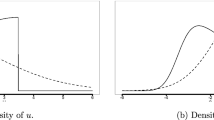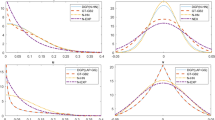Abstract
Estimation of the one sided error component in stochastic frontier models may erroneously attribute firm characteristics to inefficiency if heterogeneity is unaccounted for. However, unobserved inefficiency heterogeneity has been little explored. In this work, we propose to capture it through a random parameter which may affect the location, scale, or both parameters of a truncated normal inefficiency distribution using a Bayesian approach. Our findings using two real data sets, suggest that the inclusion of a random parameter in the inefficiency distribution is able to capture latent heterogeneity and can be used to validate the suitability of observed covariates to distinguish heterogeneity from inefficiency. Relevant effects are also found on separating and shrinking individual posterior efficiency distributions when heterogeneity affects the location and scale parameters of the one-sided error distribution, and consequently affecting the estimated mean efficiency scores and rankings. In particular, including heterogeneity simultaneously in both parameters of the inefficiency distribution in models that satisfy the scaling property leads to a decrease in the uncertainty around the mean scores and less overlapping of the posterior efficiency distributions, which provides both more reliable efficiency scores and rankings.







Similar content being viewed by others
Notes
We also studied these effects using models that follow half-normal and exponential distributions for the inefficiency. These results are available from the authors upon request.
In a previous study, Caudill and Ford (1993) also found biased estimates of the frontier parameters.
More details on this criterion and an approximate lower bound for the LPS are described in Fernandez et al. (2001).
After performing some tests Greene (2004) chose a model that includes Gini and GDP in the inefficiency and the rest of covariates in the production function.
Among models with inefficiency heterogeneity, rank correlation is very high (0.99).
Similar results were obtained from other scaling-type models following half-normal and exponential distributions but they performed a bit worse in terms of fit and predictive performance. Results are available from authors upon request.
The original data set includes 256 observations, ten years of observations for an extra airline company. We excluded this firm since we do not have data for the exogenous variables of this airline.
Coelli et al. (1999) evaluate both alternatives for a technical efficiency analysis and conclude statistically in favor of a model including them in the inefficiency term.
For all models, monotonicity conditions were found to be not satisfied because of negative signs obtained for prices coefficients. This result was also obtained by Greene (2008). Therefore, we impose regularity conditions by requiring the cost function to have positive elasticities on prices (∂c it /∂p it > 0). We follow the procedure described in Griffin and Steel (2007) by restricting coefficients β1 to β4 to be positive through truncated normal prior distributions for these parameters.
In fact, most of the efficiency studies applied to airlines have treated size and network environment variables as frontier drivers (see Coelli et al. 1999).
References
Aigner D, Lovell C, Schmidt P (1977) Formulation and estimation of stochastic frontier production function models. J Econom 6:21–37
Alvarez A, Amsler C, Orea L, Schmidt P (2006) Interpreting and testing the scaling property in models where inefficiency depends on firm characteristics. J Prod Anal 25:201–212
Battese G, Coelli T (1992) Frontier production functions, technical efficiency and panel data: with application to paddy farmers in India. J Prod Anal 3:153–169
Battese G, Coelli T (1995) A model for technical inefficiency effects in a stochastic frontier production model for panel data. Empir Econ 20:325–332
Caudill S, Ford J (1993) Biases in frontier estimation due to heteroscedasticity. Econ Lett 41:17–20
Caudill S, Ford J, Gropper D (1995) Frontier estimation and firm-specific inefficiency measures in the presence of heteroskedasticity. J Bus Econom Stat 13:105–111
Celeux G, Forbes F, Robert C, Titterington D (2006) Deviance information criteria for missing data models. Bayesian Anal 4:651–674
Coelli T, Perelman S, Romano E (1999) Accounting for environmental influences in stochastic frontier models: with application to international airlines. J Prod Anal 11:251–273
Evans D, Tandon A, Murray C, Lauer J (2000) The comparative efficiency of national health systems in producing health: an analysis of 191 countries. Discussion paper no. 29, World Health Organization, EIP/GPE/EQC
Fernandez C, Ley E, Steel M (2001) Benchmark priors for Bayesian model averaging. J Econom 100:381–427
Ferreira J, Steel M (2007) Model comparison of coordinate-free multivariate skewed distributions with an application to stochastic frontiers. J Econom 137:641–673
Good I (1952) Rational decisions. J R Stat Soc B 14:107–114
Greene W (1990) A gamma-distributed stochastic frontier model. J Econom 46:141–164
Greene W (2004) Distinguishing between heterogeneity and inefficiency: stochastic frontier analysis of the World Health Organization’s panel data on national health care systems. Health Econ 13:959–980
Greene W (2005) Reconsidering heterogeneity in panel data estimators of the stochastic frontier model. J Econom 126:269–303
Greene W (2008) The econometric approach to efficiency analysis. The measurement of productive efficiency and productivity growth, chap 2. Oxford University Press, Inc., New York, pp 959–980
Griffin J, Steel M (2004) Semiparametric Bayesian inference for stochastic frontier models. J Econom 123:121–152
Griffin J, Steel M (2007) Bayesian stochastic frontier analysis using WinBUGS. J Prod Anal 27:163–176
Griffin J, Steel M (2008) Flexible mixture modelling of stochastic frontiers. J Prod Anal 29:33–50
Hadri K (1999) Estimation of a doubly heteroscedastic stochastic frontier cost function. J Prod Anal 17:359–363
Hadri K, Guermat C, Whittaker J (2003a) Estimating farm efficiency in the presence of double heteroscedasticity using panel data. J Appl Econ 2:255–268
Hadri K, Guermat C, Whittaker J (2003b) Estimation of technical inefficiency effects using panel data and doubly heteroscedastic stochastic production frontiers. Empir Econ 28:203–222
Huang H (2004) Estimation of technical inefficiencies with heterogeneous technologies. J Prod Anal 21:277–296
Huang H, Liu J (1994) Estimation of a non-neutral stochastic frontier production function. J Prod Anal 5:171–180
Koop G, Osiewalski J, Steel M (1997) Bayesian efficiency analysis through individual effects: hospital cost frontiers. J Econom 76:77–106
Koop G, Steel M, Osiewalski J (1995) Posterior analysis of stochastic frontier models using Gibbs sampling. Comput Stat 10:353–373
Kumbhakar S, Ghosh S, McGuckin J (1991) A generalized production frontier approach for estimating determinants of inefficiency in US dairy farms. J Bus Econ Stat 9:279–286
Kumbhakar S, Lovell C (2000) Stochastic frontier analysis. Cambridge University Press, New York
Li Y, Zeng T, Yu J (2012) Robust deviance information criterion for latent variable models. Singapore Management University, Research Collection School of Economics (Open Access). Paper 1403
Meeusen W, van den Broeck J (1977) Efficiency estimation from Cobb–Douglas production functions with composed errors. Int Econ Rev 8:435–444
Reifschnieder D, Stevenson R (1991) Systematic departures from the frontier: a framework for the analysis of firm inefficiency. Int Econ Rev 32:715–723
Richardson S (2002) Discussion of spiegelhalter et al. J R Stat Soc B 64:626–627
Simar L, Lovell C, van den Eeckaut P (1994). Stochastic frontiers incorporating exogenous influences on efficiency. Discussion paper no. 9403, Institut de Statistique, Universit Catholique de Louvain
Spiegelhalter D, Best N, Carlin B, van der Linde A (2002) Bayesian measures of model complexity and fit. J R Stat Soc 64(4):583–639
Stevenson R (1980) Likelihood functions for generalized stochastic frontier estimation. J Econom 13:57–66
Tsionas E (2002) Stochastic frontier models with random coefficients. J Appl Econom 17:127–147
van den Broeck J, Koop G, Osiewalski J, Steel M (1994) Stochastic frontier models: a bayesian perspective. J Econom 61:273–303
Wang H (2002) Heteroscedasticity and non-monotonic efficiency effects of a stochastic frontier model. J Prod Anal 18:241–253
Wang H, Schmidt P (2002) One step and two step estimation of the effects of exogenous variables on technical efficiency levels. J Prod Anal 18:129–144
WHO (2000) Health systems: improving performance. The World Health report. World Health Organization, Geneva
Acknowledgments
The authors would like to thank Mark Steel and Jim Griffin for their comments and suggestions as well as the participants of the 33rd National Congress on Statistics and Operations Research and the Permanent Seminar on Efficiency and Productivity of Universidad de Oviedo. Financial support from the Spanish Ministry of Education and Science, research projects ECO2012-3401, MTM2010-17323 and SEJ2007-64500 is also gratefully acknowledged.
Author information
Authors and Affiliations
Corresponding author
Rights and permissions
About this article
Cite this article
Galán, J.E., Veiga, H. & Wiper, M.P. Bayesian estimation of inefficiency heterogeneity in stochastic frontier models. J Prod Anal 42, 85–101 (2014). https://doi.org/10.1007/s11123-013-0377-4
Published:
Issue Date:
DOI: https://doi.org/10.1007/s11123-013-0377-4




